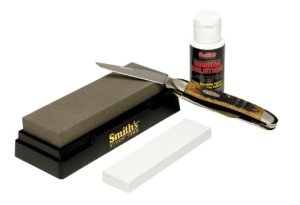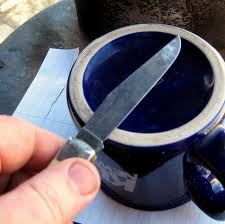How to Sharpen a Knife Without a Sharpener
How to Sharpen a Knife Without a Sharpener- Is it possible?
In actuality, you should always sharpen your knives with a sharpener. Using a knife sharpener to sharpen your knives guarantees that the right amount of pressure will be applied to the blade to give the edge razor sharpness. However, say, for example, if you are camping or hunting, you probably do not want to carry a knife sharpener around with you.
You will be happy to know that there are a few other ways to keep your knives sharp without using a knife sharpener. Below are the items you can substitute for a knife sharpener, and the steps you will need to take to get the same results.
Whetstone or Diamond Stone Knife Sharpener
If you are enjoying an outdoor adventure such as a camping, fishing, or hunting trip, you will need to keep your knives sharpened for many reasons. To do so, without the benefits of a knife sharpener, you can pack a whetstone or diamond stone with your gear. It is not only more lightweight than a knife sharpener, but it will do the job just as good.
The first thing you want to do before you use your whetstone or diamond stone is to choose an angle to sharpen your knife. If you don’t know beforehand what angle your knife is sharpened at, you can’t go wrong with choosing a 10-30 degree angle for each side of your knife blade. A shallow angle will make a sharp edge that will not last long. A steeper angle will be sturdier, so 17-20 degrees will be an excellent compromise between the two.
The next step is to wet your whetstone or diamond stone with a light oil, such as honing or mineral oil. This will make it easier for the blade to pass over the whetstone or diamond stone when you are sharpening it. Moreover, the oiling of the whetstone or diamond stone will keep the shavings from clogging the pores of the stones.
An important note about oiling sharpening stones: most are carborundum stones, which mean they can be used wet or dry. However, oil will ruin them. Therefore, it is best to look for stones that specifically say “oiling stones.”
After oiling your stone, place a sharpening guide underneath your knife to keep the blade at a precise angle when you are scraping the knife across the stone. If you don’t use one, you will have to keep the knife steady by your hand that can be difficult if you are not experienced in angle perceptions.
One of the difficult parts of sharpening a knife using a whetstone or a diamond stone is getting the right angle. A suggestion to help you with this is to mark the very tip of your knife on both sides with a sharpie pen, and throughout the sharpening task, check to see if the mark is being removed.
Similar to a nail file, one side on the whetstone or diamond stone is rough, and one side is fine. You need to start with the rough side. To create a symmetrical edge, place the knife on the stone sideways, and drag it towards you until your grind goes halfway through the steel. After you feel for the burr, flip the knife over and do the other side.
After you finish sharpening the knife with the rough side of the stone, turn the stone over to the fine side and continue to sharpen the knife in the same way you did with the rough side. This will smooth over and remove the burrs. This will make a fine, honed edge. Don’t forget to flip your knife over and smooth the other side.
To get the smoothest blade, glide your knife over the fine side, and immediately flip it over and glide the other side over the stone. You can further polish the blade of your knife by continuing to glide your knife’s blade over the stone. This will help your knife to cut through an object with a gentle push, such as a tomato, without slicing through it.
Honing Rod

Another way to keep your favorite skinning knife blade sharpen without the luxury of a knife sharpener is to use a honing rod. It is important to note that a honing rod will not make a dull blade sharp again. Instead, a honing rod is used to keep your knife sharp in between sharpening it with a knife sharpener.
Furthermore, a honing rod reduces the need for you to use a whetstone or diamond stone to sharpen your knives, which can cut metal off the edge of your blade. The less you use a whetstone or diamond stone to sharpen your knives, the longer your knives will last.
A honing rod can:
- Realign the Metal of Your Knife
- Amend Small Nicks/Indentations
- Flatten Spots
Unlike a whetstone or a diamond stone, a honing rod will not remove a large amount of metal from your knife. It is really simple to use a honing rod. Holding it away from you at a comfortable angle, and with the knife in your dominant hand, slide it across the top of the honing rod. You should be gliding your knife from heel to tip across the honing rod.
Coffee Mug Knife Sharpening
It might surprise you that you can use a coffee mug to sharpen your knife, due to the ceramic material of the coffee mug. Turning the cup over, and keeping your knife at a 20-degree angle, glide the knife over the bottom of the coffee mug several times. Remember to flip your knife over to get both sides done.
How to Sharpen a Serrated Knife
Like knives with regular blades, serrated knives require regular sharpening to keep the blades from growing dull. Because of the obvious difference in the blade’s style, you can’t use the same knife sharpener for serrated blades that you use for regular blades.
One of the best products for sharpening serrated knives is a ceramic serrated knife sharpening tool. A rod-shaped item, it is tapered at one end to accommodate the differently sized serrations.
The first thing you want to do is locate which side of your serrated knife has the beveled edge. The beveled edge is typically the one in which the face of the blade angles down slightly right before the serrated edge. This is the side you will be sharpening.
Placing the rod in one of the serrated grooves, slice the serrated sharpening tool towards you with short strokes in each serrated groove. After running the serrated sharpening tool across a serrated groove, check for burrs or metal shavings. If you can feel a burr, you have done the job right.
Whether you have a regular or serrated blade knife, you will want to keep the blades sharpened to give your tools longevity. This will save you money in the long run.




